SELECTs and JOINs From System Views for Extended Events in SQL Server
Applies to:
SQL Server
Azure SQL Database
Azure SQL Managed Instance
This article explains the two sets of system views that relate to Extended Events in SQL Server and in Azure SQL Database. The article illustrates:
- How to JOIN various system views.
- How to SELECT particular kinds of information from the system views.
- How the same event session information is represented from various technological perspectives, which reinforces your understanding of each perspective.
Most of the examples are written for SQL Server. But with minor edits they would run on SQL Database.
A. Foundational information
There are two sets of system views for Extended Events:
Catalog views:
These views store information about the definition of each event session that is created by CREATE EVENT SESSION, or by an SSMS UI equivalent. But these views know nothing about whether any sessions have ever started running.
- For example, if the SSMS Object Explorer shows no event sessions are defined, SELECTing from the view sys.server_event_session_targets would return zero rows.
Name prefix is:
- sys.server_event_session* is the name prefix on SQL Server.
- sys.database_event_session* is the name prefix on SQL Database.
Dynamic management views (DMVs):
Store information about the current activity of running event sessions. But these DMVs know little about the definition of the sessions.
- Even if all event sessions are currently stopped, a SELECT from the view sys.dm_xe_packages would still return rows because various packages are loaded into active memory a server start.
- For the same reason, sys.dm_xe_objects sys.dm_xe_object_columns would also still return rows.
Name prefix for Extended Events DMVs is:
- sys.dm_xe_* is the name prefix on SQL Server.
- sys.dm_xe_database_* is generally the name prefix on SQL Database.
Permissions:
To SELECT from the system views, the following permission is necessary:
- VIEW SERVER STATE - if on Microsoft SQL Server.
- VIEW DATABASE STATE - if on Azure SQL Database.
B. Catalog views
This section matches and correlates three different technological perspectives on the same defined event session. The session has been defined and is visible in the Object Explorer of SQL Server Management Studio (SSMS.exe), but the session is not currently running.
Every month it is wise to install the latest update of SSMS, to avoid unexpected failures.
Reference documentation about the catalog views for Extended Events is at Extended Events Catalog Views (Transact-SQL).
The sequence in this section B:
-
- Create the definition of the event session, by using the SSMS UI. Step-by-step screenshots are shown.
-
- Use the SSMS context menu to reverse engineer the defined event session into the equivalent Transact-SQL CREATE EVENT SESSION statement. The T-SQL shows a perfect match to the SSMS screenshots choices.
B.3 Catalog view SELECT JOIN UNION perspective
- Issue a T-SQL SELECT statement from the system catalog views for our event session. The results match the CREATE EVENT SESSION statement specifications.
B.1 SSMS UI perspective
In SSMS, in its Object Explorer, you can start the New Session dialog by expanding Management > Extended Events, and then right-clicking Sessions > New Session.
In the large New Session dialog, in its first section labeled General, we see the option has been selected to Start the event session at server startup.
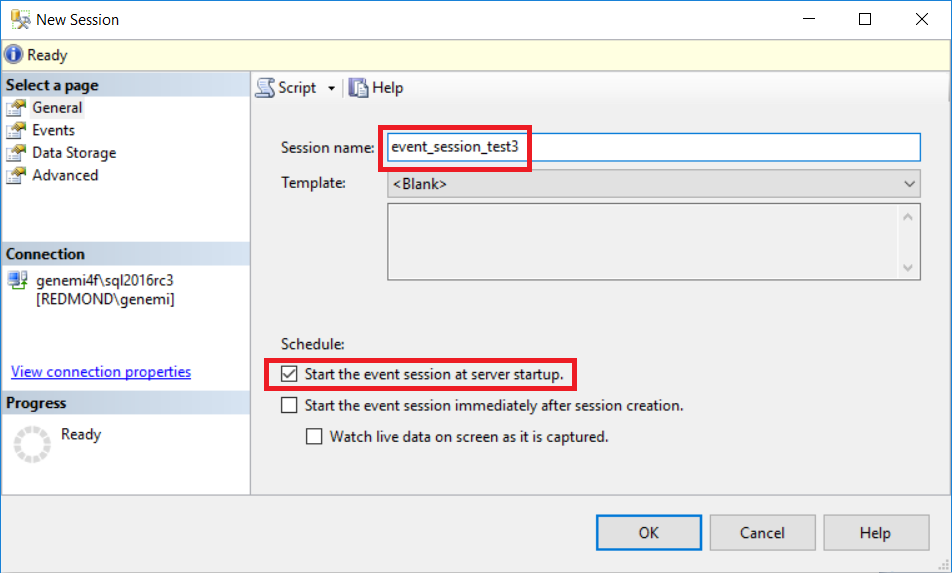
Next on the Events section, we see the lock_deadlock event was chosen. For that event, we see that three Actions have been selected. This means the Configure button was clicked, which becomes gray after being clicked.
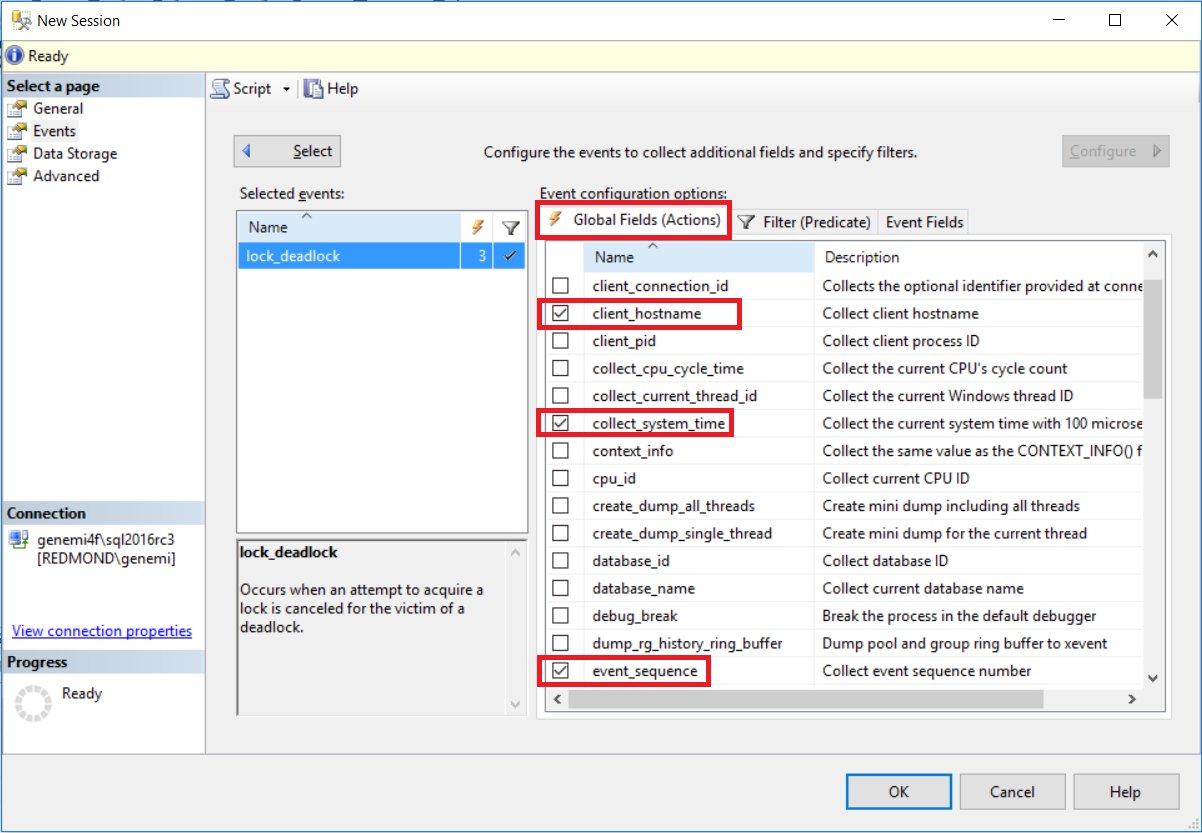
Next, still on the Events > Configure section, we see that resource_type has been set to PAGE. This means that event data will not be sent from the event engine to the target if the resource_type value is anything other than PAGE.
We see additional predicate filters for the database name and for a counter.
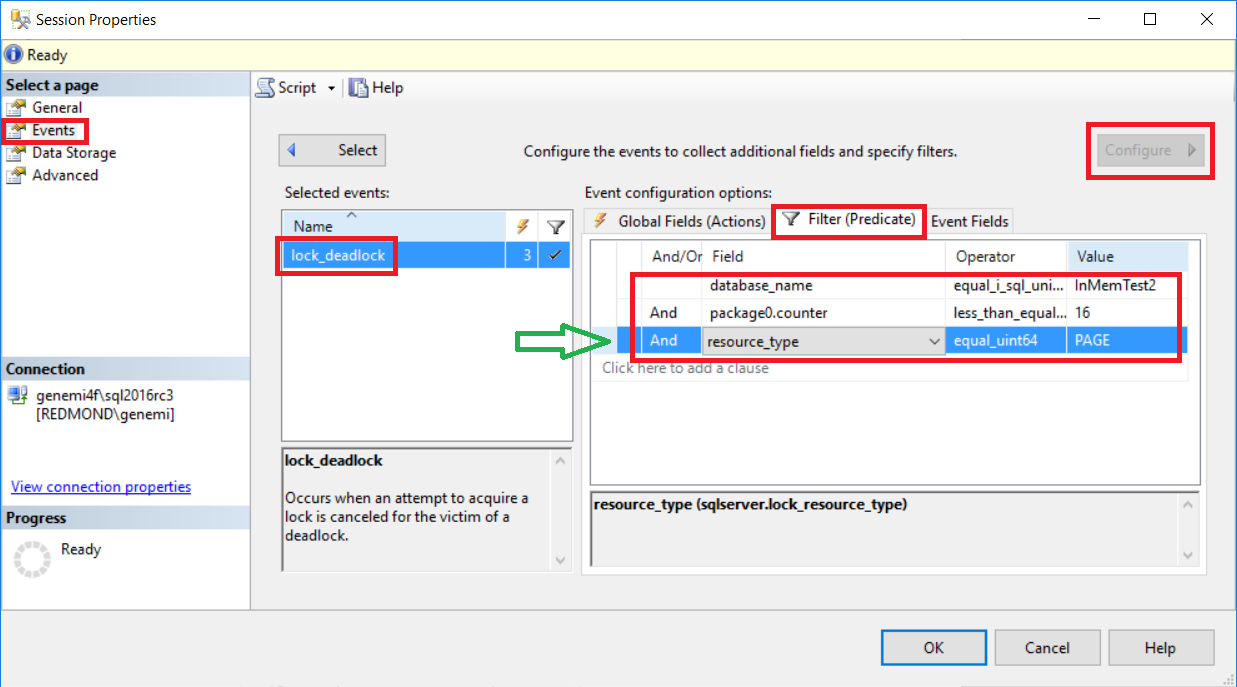
Next on the Data Storage section, we see the event_file has been chosen as a target. Further, we see that the Enable file roleover option has been selected.
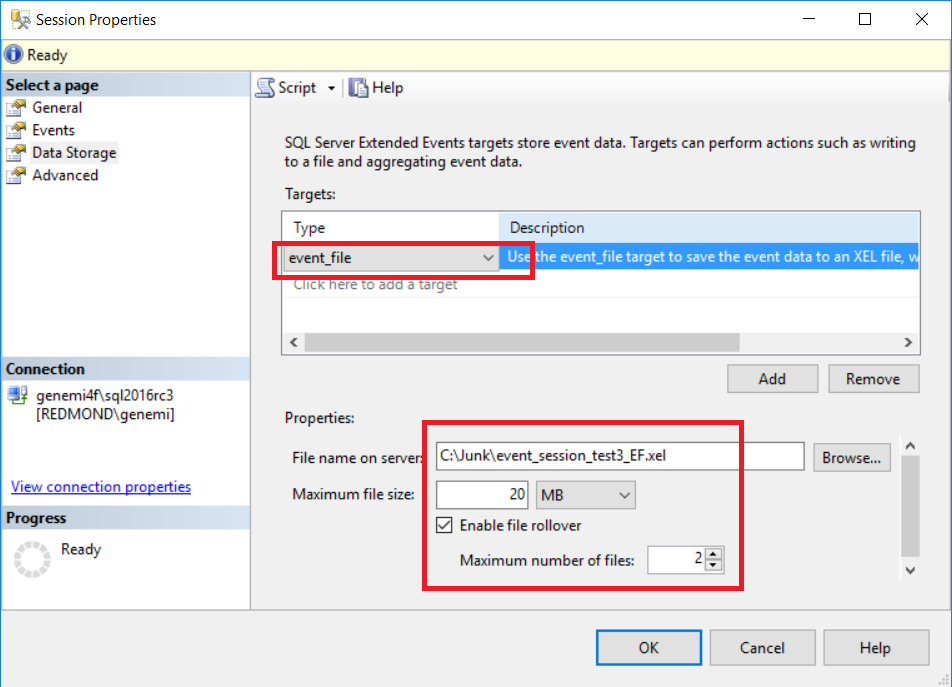
Finally, on the Advanced section, we see that the Maximum dispatch latency value was reduced down to 4 seconds.
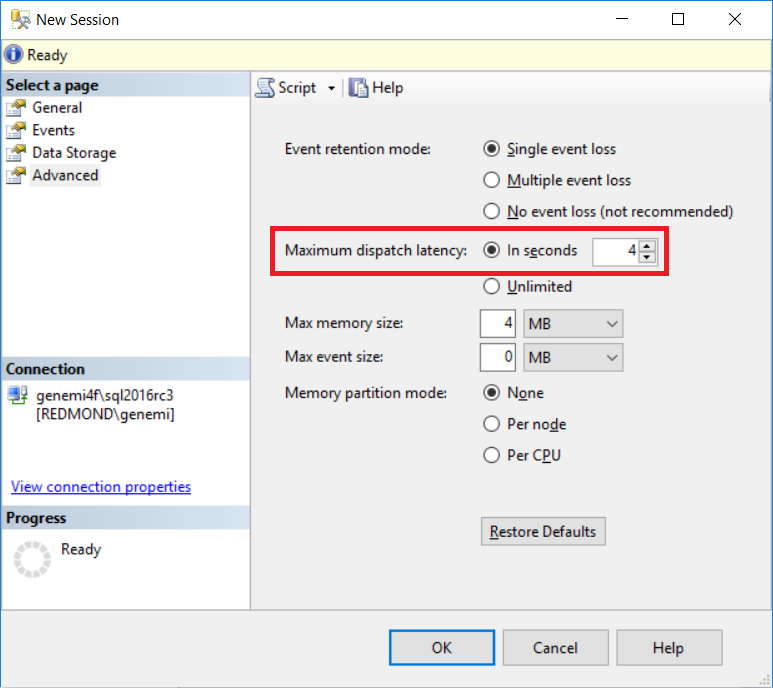
This completes the SSMS UI perspective on an event session definition.
B.2 Transact-SQL perspective
Regardless of how an event session definition is created, from the SSMS UI the session can be reversed engineered into a perfectly matching Transact-SQL script. You can examine the preceding New Session screenshots and compare their visible specifications to the clauses in the following generated T-SQL CREATE EVENT SESSION script.
To reverse engineer an event session, in the Object Explorer you can right-click your session node, and then choose Script Session as > CREATE to > Clipboard.
The following T-SQL script was created by reverse engineering with SSMS. Then the script was manually prettified by strategic manipulation of white space only.
CREATE EVENT SESSION [event_session_test3]
ON SERVER -- Or, if on Azure SQL Database, ON DATABASE.
ADD EVENT sqlserver.lock_deadlock
(
SET
collect_database_name = (1)
ACTION
(
package0 .collect_system_time,
package0 .event_sequence,
sqlserver .client_hostname
)
WHERE
(
[database_name] = N'InMemTest2'
AND [package0].[counter] <= (16)
AND [resource_type] = (6)
)
)
ADD TARGET package0.event_file
(
SET
filename = N'C:\Junk\event_session_test3_EF.xel',
max_file_size = (20),
max_rollover_files = (2)
)
WITH
(
MAX_MEMORY = 4096 KB,
EVENT_RETENTION_MODE = ALLOW_SINGLE_EVENT_LOSS,
MAX_DISPATCH_LATENCY = 4 SECONDS,
MAX_EVENT_SIZE = 0 KB,
MEMORY_PARTITION_MODE = NONE,
TRACK_CAUSALITY = OFF,
STARTUP_STATE = ON
);
This completes the T-SQL perspective.
B.3 Catalog view SELECT JOIN UNION perspective
Do not be afraid! The following T-SQL SELECT statement is long only because it UNIONs several small SELECTs together. Any of the small SELECTs can be run on its own. The small SELECTs show how the various system cataloging views should be JOINed together.
SELECT
s.name AS [Session-Name],
'1_EVENT' AS [Clause-Type],
'Event-Name' AS [Parameter-Name],
e.name AS [Parameter-Value]
FROM
sys.server_event_sessions AS s
JOIN sys.server_event_session_events AS e
ON e.event_session_id = s.event_session_id
WHERE
s.name = 'event_session_test3'
UNION ALL
SELECT
s.name AS [Session-Name],
'2_EVENT_SET' AS [Clause-Type],
f.name AS [Parameter-Name],
f.value AS [Parameter-Value]
FROM
sys.server_event_sessions AS s
JOIN sys.server_event_session_events AS e
ON e.event_session_id = s.event_session_id
JOIN sys.server_event_session_fields As f
ON f.event_session_id = s.event_session_id
AND f.object_id = e.event_id
WHERE
s.name = 'event_session_test3'
UNION ALL
SELECT
s.name AS [Session-Name],
'3_EVENT_ACTION' AS [Clause-Type],
a.package + '.' + a.name
AS [Parameter-Name],
'(Not_Applicable)' AS [Parameter-Value]
FROM
sys.server_event_sessions AS s
JOIN sys.server_event_session_events AS e
ON e.event_session_id = s.event_session_id
JOIN sys.server_event_session_actions As a
ON a.event_session_id = s.event_session_id
AND a.event_id = e.event_id
WHERE
s.name = 'event_session_test3'
UNION ALL
SELECT
s.name AS [Session-Name],
'4_EVENT_PREDICATES' AS [Clause-Type],
e.predicate AS [Parameter-Name],
'(Not_Applicable)' AS [Parameter-Value]
FROM
sys.server_event_sessions AS s
JOIN sys.server_event_session_events AS e
ON e.event_session_id = s.event_session_id
WHERE
s.name = 'event_session_test3'
UNION ALL
SELECT
s.name AS [Session-Name],
'5_TARGET' AS [Clause-Type],
t.name AS [Parameter-Name],
'(Not_Applicable)' AS [Parameter-Value]
FROM
sys.server_event_sessions AS s
JOIN sys.server_event_session_targets AS t
ON t.event_session_id = s.event_session_id
WHERE
s.name = 'event_session_test3'
UNION ALL
SELECT
s.name AS [Session-Name],
'6_TARGET_SET' AS [Clause-Type],
f.name AS [Parameter-Name],
f.value AS [Parameter-Value]
FROM
sys.server_event_sessions AS s
JOIN sys.server_event_session_targets AS t
ON t.event_session_id = s.event_session_id
JOIN sys.server_event_session_fields As f
ON f.event_session_id = s.event_session_id
AND f.object_id = t.target_id
WHERE
s.name = 'event_session_test3'
UNION ALL
SELECT
s.name AS [Session-Name],
'7_WITH_MAX_MEMORY' AS [Clause-Type],
'max_memory' AS [Parameter-Name],
s.max_memory AS [Parameter-Value]
FROM
sys.server_event_sessions AS s
WHERE
s.name = 'event_session_test3'
UNION ALL
SELECT
s.name AS [Session-Name],
'7_WITH_STARTUP_STATE' AS [Clause-Type],
'startup_state' AS [Parameter-Name],
s.startup_state AS [Parameter-Value]
FROM
sys.server_event_sessions AS s
WHERE
s.name = 'event_session_test3'
ORDER BY
[Session-Name],
[Clause-Type],
[Parameter-Name]
;
Output
The following table shows the output from running the preceding SELECT JOIN UNION. The output parameter names and values map to what is plainly visible in the preceding CREATE EVENT SESSION statement.
| Session-Name | Clause-Type | Parameter-Name | Parameter-Value |
|---|---|---|---|
| event_session_test3 | 1_EVENT | Event-Name | lock_deadlock |
| event_session_test3 | 2_EVENT_SET | collect_database_name | 1 |
| event_session_test3 | 3_EVENT_ACTION | sqlserver.client_hostname | (Not_Applicable) |
| event_session_test3 | 3_EVENT_ACTION | sqlserver.collect_system_time | (Not_Applicable) |
| event_session_test3 | 3_EVENT_ACTION | sqlserver.event_sequence | (Not_Applicable) |
| event_session_test3 | 4_EVENT_PREDICATES | ([sqlserver].[equal_i_sql_unicode_string]([database_name],N'InMemTest2') AND [package0].[counter]<=(16)) | (Not_Applicable) |
| event_session_test3 | 5_TARGET | event_file | (Not_Applicable) |
| event_session_test3 | 6_TARGET_SET | filename | C:\Junk\event_session_test3_EF.xel |
| event_session_test3 | 6_TARGET_SET | max_file_size | 20 |
| event_session_test3 | 6_TARGET_SET | max_rollover_files | 2 |
| event_session_test3 | 7_WITH_MAX_MEMORY | max_memory | 4096 |
| event_session_test3 | 7_WITH_STARTUP_STATE | startup_state | 1 |
This completes the section on catalog views.
C. Dynamic management views (DMVs)
We now shift to DMVs. This section provides several Transact-SQL SELECT statements which each serve a specific useful business purpose. Further, the SELECTs demonstrate how you can JOIN the DMVs together for any new uses you want.
Reference documentation of the DMVs is available at Extended Events Dynamic Management Views
In this article, any actual output rows from the following SELECTs are from SQL Server 2016, unless otherwise specified.
Here is list of the SELECTs in this DMV section C:
- C.1 List of all packages
- C.2 Count of every object type
- C.3 SELECT all available items sorted by type
- C.4 Data fields available for your event
- C.5 sys.dm_xe_map_values and event fields
- C.6 Parameters for targets
- C.7 DMV SELECT casting target_data column to XML
- C.8 SELECT from a function to retrieve event_file data from disk drive
C.1 List of all packages
All the objects you can use in area of extended events come from packages which are loaded into the system. This section lists all the packages and their descriptions.
SELECT --C.1
p.name AS [Package],
p.description AS [Package-Description]
FROM
sys.dm_xe_packages AS p
ORDER BY
p.name;
Output
Here is the list of packages.
| Package | Package-Description |
|---|---|
| filestream | Extended events for SQL Server FILESTREAM and FileTable |
| package0 | Default package. Contains all standard types, maps, compare operators, actions and targets |
| qds | Extended events for Query Store |
| SecAudit | Security Audit Events |
| sqlclr | Extended events for SQL CLR |
| sqlos | Extended events for SQL Operating System |
| SQLSatellite | Extended events for SQL Satellite |
| sqlserver | Extended events for Microsoft SQL Server |
| sqlserver | Extended events for Microsoft SQL Server |
| sqlserver | Extended events for Microsoft SQL Server |
| sqlsni | Extended events for Microsoft SQL Server |
| ucs | Extended events for Unified Communications Stack |
| XtpCompile | Extended events for the XTP Compile |
| XtpEngine | Extended events for the XTP Engine |
| XtpRuntime | Extended events for the XTP Runtime |
Definitions of the preceding initialisms:
- clr = Common Language Runtime of .NET
- qds = Query Data Store
- sni = Server Network Interface
- ucs = Unified Communications Stack
- xtp = extreme transaction processing
C.2 Count of every object type
This section tells us about the type of objects that event packages contain. A complete list is displayed of all object types that are in sys.dm_xe_objects, along with the count for each type.
SELECT --C.2
Count(*) AS [Count-of-Type],
o.object_type
FROM
sys.dm_xe_objects AS o
GROUP BY
o.object_type
ORDER BY
1 DESC;
Output
Here is the count of objects per object type. There are about 1915 objects.
| Count-of-Type | object_type |
|---|---|
| 1303 | event |
| 351 | map |
| 84 | message |
| 77 | pred_compare |
| 53 | action |
| 46 | pred_source |
| 28 | type |
| 17 | target |
C.3 SELECT all available items sorted by type
The following SELECT returns about 1915 rows, one for each object.
SELECT --C.3
o.object_type AS [Type-of-Item],
p.name AS [Package],
o.name AS [Item],
o.description AS [Item-Description]
FROM
sys.dm_xe_objects AS o
JOIN sys.dm_xe_packages AS p ON o.package_guid = p.guid
WHERE
o.object_type IN ('action' , 'target' , 'pred_source')
AND
(
(o.capabilities & 1) = 0
OR
o.capabilities IS NULL
)
ORDER BY
[Type-of-Item],
[Package],
[Item];
Output
To whet your appetite, next is an arbitrary sampling of the objects returned by the preceding SELECT.
| Type-of-Item | Package | Item | Item-Description |
|---|---|---|---|
| action | package0 | callstack | Collect the current call stack |
| action | package0 | debug_break | Break the process in the default debugger |
| action | sqlos | task_time | Collect current task execution time |
| action | sqlserver | sql_text | Collect SQL text |
| event | qds | query_store_aprc_regression | Fired when Query Store detects regression in query plan performance |
| event | SQLSatellite | connection_accept | Occurs when a new connection is accepted. This event serves to log all connection attempts. |
| event | XtpCompile | cgen | Occurs at start of C code generation. |
| map | qds | aprc_state | Query Store Automatic Plan Regression Correction state |
| message | package0 | histogram_event_required | A value is required for the parameter 'filtering_event_name' when source type is 0. |
| pred_compare | package0 | equal_ansi_string | Equality operator between two ANSI string values |
| pred_compare | sqlserver | equal_i_sql_ansi_string | Equality operator between two SQL ANSI string values |
| pred_source | sqlos | task_execution_time | Get current task execution time |
| pred_source | sqlserver | client_app_name | Get the current client application name |
| target | package0 | etw_classic_sync_target | Event Tracing for Windows (ETW) Synchronous Target |
| target | package0 | event_counter | Use the event_counter target to count the number of occurrences of each event in the event session. |
| target | package0 | event_file | Use the event_file target to save the event data to an XEL file, which can be archived and used for later analysis and review. You can merge multiple XEL files to view the combined data from separate event sessions. |
| target | package0 | histogram | Use the histogram target to aggregate event data based on a specific event data field or action associated with the event. The histogram allows you to analyze distribution of the event data over the period of the event session. |
| target | package0 | pair_matching | Pairing target |
| target | package0 | ring_buffer | Asynchronous ring buffer target |
| type | package0 | xml | Well formed XML fragment |
C.4 Data fields available for your event
The following SELECT returns all the data fields that are particular to your event type.
- Note the WHERE clause item: column_type = 'data'.
- Also, you would need to edit the WHERE clause value for o.name =.
SELECT -- C.4
p.name AS [Package],
c.object_name AS [Event],
c.name AS [Column-for-Predicate-Data],
c.description AS [Column-Description]
FROM
sys.dm_xe_object_columns AS c
JOIN sys.dm_xe_objects AS o
ON o.name = c.object_name
JOIN sys.dm_xe_packages AS p
ON p.guid = o.package_guid
WHERE
c.column_type = 'data'
AND
o.object_type = 'event'
AND
o.name = '\<EVENT-NAME-HERE!>' --'lock_deadlock'
ORDER BY
[Package],
[Event],
[Column-for-Predicate-Data];
Output
The following rows were returned by the preceding SELECT, WHERE o.name = 'lock_deadlock':
- Each row represents an optional filter for the sqlserver.lock_deadlock event.
- The [Column-Description] column is omitted from the following display. Its value is often NULL.
- This is actual output, except for the omitted Description column which is often NULL.
- These rows are where object_type = 'lock_deadlock'.
| Package | Event | Column-for-Predicate-Data |
|---|---|---|
| sqlserver | lock_deadlock | associated_object_id |
| sqlserver | lock_deadlock | database_id |
| sqlserver | lock_deadlock | database_name |
| sqlserver | lock_deadlock | deadlock_id |
| sqlserver | lock_deadlock | duration |
| sqlserver | lock_deadlock | lockspace_nest_id |
| sqlserver | lock_deadlock | lockspace_sub_id |
| sqlserver | lock_deadlock | lockspace_workspace_id |
| sqlserver | lock_deadlock | mode |
| sqlserver | lock_deadlock | object_id |
| sqlserver | lock_deadlock | owner_type |
| sqlserver | lock_deadlock | resource_0 |
| sqlserver | lock_deadlock | resource_1 |
| sqlserver | lock_deadlock | resource_2 |
| sqlserver | lock_deadlock | resource_description |
| sqlserver | lock_deadlock | resource_type |
| sqlserver | lock_deadlock | transaction_id |
C.5 sys.dm_xe_map_values and event fields
The following SELECT includes a JOIN to the tricky view named sys.dm_xe_map_values.
The purpose of the SELECT display the numerous fields that you can choose from for your event session. The event fields can be used in two ways:
- To choose which field values will be written to your target for each event occurrence..
- To filter which event occurrences will be sent to versus kept from your target.
SELECT --C.5
dp.name AS [Package],
do.name AS [Object],
do.object_type AS [Object-Type],
'o--c' AS [O--C],
dc.name AS [Column],
dc.type_name AS [Column-Type-Name],
dc.column_type AS [Column-Type],
dc.column_value AS [Column-Value],
'c--m' AS [C--M],
dm.map_value AS [Map-Value],
dm.map_key AS [Map-Key]
FROM
sys.dm_xe_objects AS do
JOIN sys.dm_xe_object_columns AS dc
ON dc.object_name = do.name
JOIN sys.dm_xe_map_values AS dm
ON dm.name = dc.type_name
JOIN sys.dm_xe_packages AS dp
ON dp.guid = do.package_guid
WHERE
do.object_type = 'event'
AND
do.name = '\<YOUR-EVENT-NAME-HERE!>' --'lock_deadlock'
ORDER BY
[Package],
[Object],
[Column],
[Map-Value];
Output
Next is a sampling of the actual 153 rows of output from the preceding T-SQL SELECT. The row for resource_type is relevant to the predicate filtering used in the event_session_test3 example elsewhere in this article.
/*** 5 sampled rows from the actual 153 rows returned.
NOTE: 'resource_type' under 'Column'.
Package Object Object-Type O--C Column Column-Type-Name Column-Type Column-Value C--M Map-Value Map-Key
------- ------ ----------- ---- ------ ---------------- ----------- ------------ ---- --------- -------
sqlserver lock_deadlock event o--c CHANNEL etw_channel readonly 2 c--m Operational 4
sqlserver lock_deadlock event o--c KEYWORD keyword_map readonly 16 c--m access_methods 1024
sqlserver lock_deadlock event o--c mode lock_mode data NULL c--m IX 8
sqlserver lock_deadlock event o--c owner_type lock_owner_type data NULL c--m Cursor 2
sqlserver lock_deadlock event o--c resource_type lock_resource_type data NULL c--m PAGE 6
Therefore, on your CREATE EVENT SESSION statement, in its ADD EVENT WHERE clause,
you could put:
WHERE( ... resource_type = 6 ...) -- Meaning: 6 = PAGE.
***/
C.6 Parameters for targets
The following SELECT returns every parameter for your target. Each parameter is tagged to indicate whether it is mandatory. The values you assign to parameters affect the behavior of the target.
- Note the WHERE clause item: object_type = 'customizable'.
- Also, you would need to edit the WHERE clause value for o.name =.
SELECT --C.6
p.name AS [Package],
o.name AS [Target],
c.name AS [Parameter],
c.type_name AS [Parameter-Type],
CASE c.capabilities_desc
WHEN 'mandatory' THEN 'YES_Mandatory'
ELSE 'Not_mandatory'
END AS [IsMandatoryYN],
c.description AS [Parameter-Description]
FROM
sys.dm_xe_objects AS o
JOIN sys.dm_xe_packages AS p
ON o.package_guid = p.guid
LEFT OUTER JOIN sys.dm_xe_object_columns AS c
ON o.name = c.object_name
AND c.column_type = 'customizable' -- !
WHERE
o.object_type = 'target'
AND
o.name LIKE '%' -- Or '\<YOUR-TARGET-NAME-HERE!>'.
ORDER BY
[Package],
[Target],
[IsMandatoryYN] DESC,
[Parameter];
Output
The following rows of parameters are a subset of those returned by the preceding SELECT, in SQL Server 2016.
/*** Actual output, all rows, where target name = 'event_file'.
Package Target Parameter Parameter-Type IsMandatoryYN Parameter-Description
------- ------ --------- -------------- ------------- ---------------------
package0 event_file filename unicode_string_ptr YES_Mandatory Specifies the location and file name of the log
package0 event_file increment uint64 Not_mandatory Size in MB to grow the file
package0 event_file lazy_create_blob boolean Not_mandatory Create blob upon publishing of first event buffer, not before.
package0 event_file max_file_size uint64 Not_mandatory Maximum file size in MB
package0 event_file max_rollover_files uint32 Not_mandatory Maximum number of files to retain
package0 event_file metadatafile unicode_string_ptr Not_mandatory Not used
***/
C.7 DMV SELECT casting target_data column to XML
This DMV SELECT returns data rows from the target of your active event session. The data is cast to XML, which makes its returned cell clickable for easy display in SSMS.
- If your event session is stopped, this SELECT will return zero rows.
- You would need to edit the WHERE clause value for s.name =.
SELECT --C.7
s.name,
t.target_name,
CAST(t.target_data AS XML) AS [XML-Cast]
FROM
sys.dm_xe_session_targets AS t
JOIN sys.dm_xe_sessions AS s
ON s.address = t.event_session_address
WHERE
s.name = '\<Your-Session-Name-Here!>';
Output, the only row, including its XML cell
Here is the only row that is output from the preceding SELECT. The column XML-Cast contains a string of XML that SSMS understands is XML. Therefore SSMS understands it should make the XML-Cast cell clickable.
For this run:
- The s.name = value was set to an event session for the checkpoint_begin event.
- The target was a ring_buffer.
name target_name XML-Cast
---- ----------- --------
checkpoint_session_ring_buffer2 ring_buffer <RingBufferTarget truncated="0" processingTime="0" totalEventsProcessed="2" eventCount="2" droppedCount="0" memoryUsed="104"><event name="checkpoint_begin" package="sqlserver" timestamp="2016-07-09T01:28:23.508Z"><data name="database_id"><type name="uint32" package="package0" /><value>5</value></data></event><event name="checkpoint_begin" package="sqlserver" timestamp="2016-07-09T01:28:26.975Z"><data name="database_id"><type name="uint32" package="package0" /><value>5</value></data></event></RingBufferTarget>
Output, XML displayed pretty when cell is clicked
When the XML-Cast cell is clicked, the following pretty display appears.
<RingBufferTarget truncated="0" processingTime="0" totalEventsProcessed="2" eventCount="2" droppedCount="0" memoryUsed="104">
<event name="checkpoint_begin" package="sqlserver" timestamp="2016-07-09T01:28:23.508Z">
<data name="database_id">
<type name="uint32" package="package0" />
<value>5</value>
</data>
</event>
<event name="checkpoint_begin" package="sqlserver" timestamp="2016-07-09T01:28:26.975Z">
<data name="database_id">
<type name="uint32" package="package0" />
<value>5</value>
</data>
</event>
</RingBufferTarget>
C.8 SELECT from a function to retrieve event_file data from disk drive
Suppose your event session gathered some data and later was stopped. If your session was defined to use the event_file target, you could still retrieve the data by calling the function sys.fn_xe_target_read_file.
- You must edit your path and file name into the parameter of the function call, before you run this SELECT.
- Pay no attention to the extra digits that SQL system embeds into your actual .XEL file names each time you restart your session. Just give the normal root name and extension.
SELECT --C.8
f.module_guid,
f.package_guid,
f.object_name,
f.file_name,
f.file_offset,
CAST(f.event_data AS XML) AS [Event-Data-As-XML]
FROM
sys.fn_xe_file_target_read_file(
'\<YOUR-PATH-FILE-NAME-ROOT-HERE!>*.xel',
--'C:\Junk\Checkpoint_Begins_ES*.xel', -- Example.
NULL, NULL, NULL
) AS f;
Output, rows returned by SELECT FROM the function
Next are the rows returned by the preceding SELECT FROM the function. The far right XML column contains the data that is specifically about the event occurrence.
module_guid package_guid object_name file_name file_offset Event-Data-As-XML
----------- ------------ ----------- --------- ----------- -----------------
D5149520-6282-11DE-8A39-0800200C9A66 03FDA7D0-91BA-45F8-9875-8B6DD0B8E9F2 checkpoint_begin C:\Junk\Checkpoint_Begins_ES_20160615bb-_0_131125086091700000.xel 5120 <event name="checkpoint_begin" package="sqlserver" timestamp="2016-07-09T03:30:14.023Z"><data name="database_id"><value>5</value></data><action name="session_id" package="sqlserver"><value>60</value></action><action name="database_id" package="sqlserver"><value>5</value></action></event>
D5149520-6282-11DE-8A39-0800200C9A66 03FDA7D0-91BA-45F8-9875-8B6DD0B8E9F2 checkpoint_end C:\Junk\Checkpoint_Begins_ES_20160615bb-_0_131125086091700000.xel 5120 <event name="checkpoint_end" package="sqlserver" timestamp="2016-07-09T03:30:14.025Z"><data name="database_id"><value>5</value></data></event>
D5149520-6282-11DE-8A39-0800200C9A66 03FDA7D0-91BA-45F8-9875-8B6DD0B8E9F2 checkpoint_begin C:\Junk\Checkpoint_Begins_ES_20160615bb-_0_131125086091700000.xel 5632 <event name="checkpoint_begin" package="sqlserver" timestamp="2016-07-09T03:30:17.704Z"><data name="database_id"><value>5</value></data><action name="session_id" package="sqlserver"><value>60</value></action><action name="database_id" package="sqlserver"><value>5</value></action></event>
D5149520-6282-11DE-8A39-0800200C9A66 03FDA7D0-91BA-45F8-9875-8B6DD0B8E9F2 checkpoint_end C:\Junk\Checkpoint_Begins_ES_20160615bb-_0_131125086091700000.xel 5632 <event name="checkpoint_end" package="sqlserver" timestamp="2016-07-09T03:30:17.709Z"><data name="database_id"><value>5</value></data></event>
Output, one XML cell
Here is the contents of the first XML cell, from the preceding returned rowset.
<event name="checkpoint_begin" package="sqlserver" timestamp="2016-07-09T03:30:14.023Z">
<data name="database_id">
<value>5</value>
</data>
<action name="session_id" package="sqlserver">
<value>60</value>
</action>
<action name="database_id" package="sqlserver">
<value>5</value>
</action>
</event>